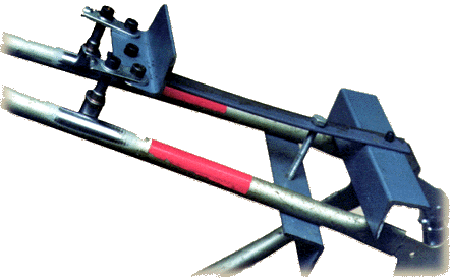
|

The crossbars on mine are made of angle iron from an old bed frame; the vertical pieces are 3/4" (19 mm) X 1/8" (3 mm) metal stock. The central vertical piece is rigidly bolted to the two crossbars, perpendicular to them.

At the top of each of the moveable arms is a 1/4" (6 mm) hole. A 6 mm bolt goes through each of these, and screws into the end of the cantilever boss. The lower crossbar rests against the stays or fork blades. A long bolt pulls up on a separate crossbar below the stays, to hold the fixture in place during brazing.
The cheaper, old style studs are two-piece, and do need to be brazed together. Modern one-piece studs cost a tiny bit more, and are well worth it.
![]()
![]()
Due to the adjustability of cantilever brakes, several possible positions may be usable for the brazed-on studs in any given application.
In some cases, it may be desirable to use a compromise mounting position for a bike that might be used with two different-size rims. In most cases, you will want to optimize for one particular rim size.
If the stud is mounted closer to the rim, so that the shoes must be set to the lower limit of their vertical position, mechanical advantage (power) will be greater than if they are farther away, so that the shoes need to be set farther away from the pivot point (the stud.)
The other major concern is the direction of travel of the brake shoe as it strikes the rim. The shoe moves in a circular arc about the stud. The farther inboard the stud is mounted, the more nearly horizontal the shoe's motion will be as it comes toward the rim.
If the studs are too far outboard, especially if narrow rims are being used, the shoes will be moving downward as much as inward when they strike the rim. This can create two possible problems:
Boss installation on the seat stays is a much less risky endeavor; even if you overheat the joint and weaken the stays, a failure here is unlikely to represent a severe hazard.
![]()
![]()
Last Updated: by Harriet Fell